Hao Xiong
Towards a Universal Synthetic Video Detector: From Face or Background Manipulations to Fully AI-Generated Content
Dec 16, 2024



Abstract:Existing DeepFake detection techniques primarily focus on facial manipulations, such as face-swapping or lip-syncing. However, advancements in text-to-video (T2V) and image-to-video (I2V) generative models now allow fully AI-generated synthetic content and seamless background alterations, challenging face-centric detection methods and demanding more versatile approaches. To address this, we introduce the \underline{U}niversal \underline{N}etwork for \underline{I}dentifying \underline{T}ampered and synth\underline{E}tic videos (\texttt{UNITE}) model, which, unlike traditional detectors, captures full-frame manipulations. \texttt{UNITE} extends detection capabilities to scenarios without faces, non-human subjects, and complex background modifications. It leverages a transformer-based architecture that processes domain-agnostic features extracted from videos via the SigLIP-So400M foundation model. Given limited datasets encompassing both facial/background alterations and T2V/I2V content, we integrate task-irrelevant data alongside standard DeepFake datasets in training. We further mitigate the model's tendency to over-focus on faces by incorporating an attention-diversity (AD) loss, which promotes diverse spatial attention across video frames. Combining AD loss with cross-entropy improves detection performance across varied contexts. Comparative evaluations demonstrate that \texttt{UNITE} outperforms state-of-the-art detectors on datasets (in cross-data settings) featuring face/background manipulations and fully synthetic T2V/I2V videos, showcasing its adaptability and generalizable detection capabilities.
Can Uncertainty Quantification Enable Better Learning-based Index Tuning?
Oct 23, 2024Abstract:Index tuning is crucial for optimizing database performance by selecting optimal indexes based on workload. The key to this process lies in an accurate and efficient benefit estimator. Traditional methods relying on what-if tools often suffer from inefficiency and inaccuracy. In contrast, learning-based models provide a promising alternative but face challenges such as instability, lack of interpretability, and complex management. To overcome these limitations, we adopt a novel approach: quantifying the uncertainty in learning-based models' results, thereby combining the strengths of both traditional and learning-based methods for reliable index tuning. We propose Beauty, the first uncertainty-aware framework that enhances learning-based models with uncertainty quantification and uses what-if tools as a complementary mechanism to improve reliability and reduce management complexity. Specifically, we introduce a novel method that combines AutoEncoder and Monte Carlo Dropout to jointly quantify uncertainty, tailored to the characteristics of benefit estimation tasks. In experiments involving sixteen models, our approach outperformed existing uncertainty quantification methods in the majority of cases. We also conducted index tuning tests on six datasets. By applying the Beauty framework, we eliminated worst-case scenarios and more than tripled the occurrence of best-case scenarios.
NesTools: A Dataset for Evaluating Nested Tool Learning Abilities of Large Language Models
Oct 15, 2024Abstract:Large language models (LLMs) combined with tool learning have gained impressive results in real-world applications. During tool learning, LLMs may call multiple tools in nested orders, where the latter tool call may take the former response as its input parameters. However, current research on the nested tool learning capabilities is still under-explored, since the existing benchmarks lack of relevant data instances. To address this problem, we introduce NesTools to bridge the current gap in comprehensive nested tool learning evaluations. NesTools comprises a novel automatic data generation method to construct large-scale nested tool calls with different nesting structures. With manual review and refinement, the dataset is in high quality and closely aligned with real-world scenarios. Therefore, NesTools can serve as a new benchmark to evaluate the nested tool learning abilities of LLMs. We conduct extensive experiments on 22 LLMs, and provide in-depth analyses with NesTools, which shows that current LLMs still suffer from the complex nested tool learning task.
CSS: Overcoming Pose and Scene Challenges in Crowd-Sourced 3D Gaussian Splatting
Sep 13, 2024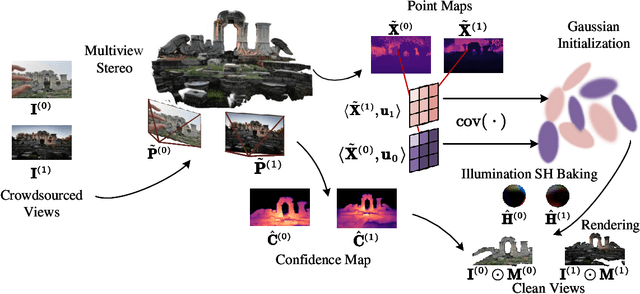
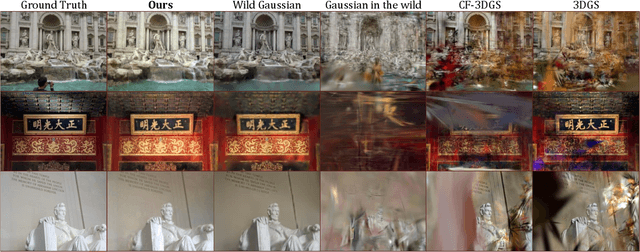

Abstract:We introduce Crowd-Sourced Splatting (CSS), a novel 3D Gaussian Splatting (3DGS) pipeline designed to overcome the challenges of pose-free scene reconstruction using crowd-sourced imagery. The dream of reconstructing historically significant but inaccessible scenes from collections of photographs has long captivated researchers. However, traditional 3D techniques struggle with missing camera poses, limited viewpoints, and inconsistent lighting. CSS addresses these challenges through robust geometric priors and advanced illumination modeling, enabling high-quality novel view synthesis under complex, real-world conditions. Our method demonstrates clear improvements over existing approaches, paving the way for more accurate and flexible applications in AR, VR, and large-scale 3D reconstruction.
Imagen 3
Aug 13, 2024Abstract:We introduce Imagen 3, a latent diffusion model that generates high quality images from text prompts. We describe our quality and responsibility evaluations. Imagen 3 is preferred over other state-of-the-art (SOTA) models at the time of evaluation. In addition, we discuss issues around safety and representation, as well as methods we used to minimize the potential harm of our models.
Modeling Collaborator: Enabling Subjective Vision Classification With Minimal Human Effort via LLM Tool-Use
Mar 05, 2024Abstract:From content moderation to wildlife conservation, the number of applications that require models to recognize nuanced or subjective visual concepts is growing. Traditionally, developing classifiers for such concepts requires substantial manual effort measured in hours, days, or even months to identify and annotate data needed for training. Even with recently proposed Agile Modeling techniques, which enable rapid bootstrapping of image classifiers, users are still required to spend 30 minutes or more of monotonous, repetitive data labeling just to train a single classifier. Drawing on Fiske's Cognitive Miser theory, we propose a new framework that alleviates manual effort by replacing human labeling with natural language interactions, reducing the total effort required to define a concept by an order of magnitude: from labeling 2,000 images to only 100 plus some natural language interactions. Our framework leverages recent advances in foundation models, both large language models and vision-language models, to carve out the concept space through conversation and by automatically labeling training data points. Most importantly, our framework eliminates the need for crowd-sourced annotations. Moreover, our framework ultimately produces lightweight classification models that are deployable in cost-sensitive scenarios. Across 15 subjective concepts and across 2 public image classification datasets, our trained models outperform traditional Agile Modeling as well as state-of-the-art zero-shot classification models like ALIGN, CLIP, CuPL, and large visual question-answering models like PaLI-X.
Enhancing Sequential Recommendation with Graph Contrastive Learning
Jun 07, 2022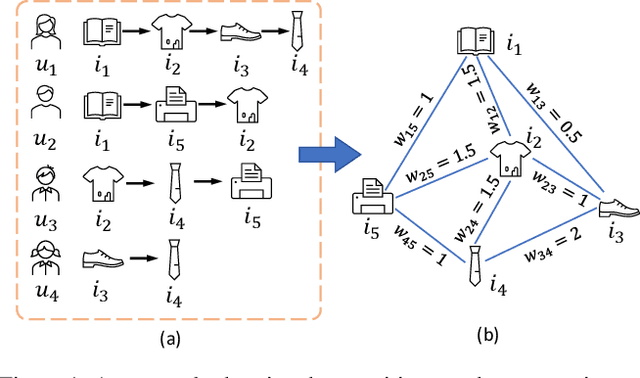

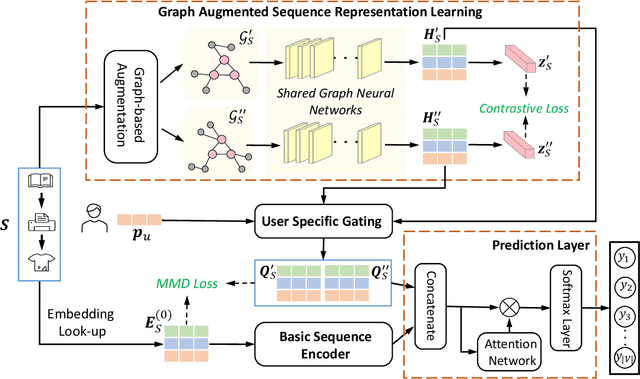

Abstract:The sequential recommendation systems capture users' dynamic behavior patterns to predict their next interaction behaviors. Most existing sequential recommendation methods only exploit the local context information of an individual interaction sequence and learn model parameters solely based on the item prediction loss. Thus, they usually fail to learn appropriate sequence representations. This paper proposes a novel recommendation framework, namely Graph Contrastive Learning for Sequential Recommendation (GCL4SR). Specifically, GCL4SR employs a Weighted Item Transition Graph (WITG), built based on interaction sequences of all users, to provide global context information for each interaction and weaken the noise information in the sequence data. Moreover, GCL4SR uses subgraphs of WITG to augment the representation of each interaction sequence. Two auxiliary learning objectives have also been proposed to maximize the consistency between augmented representations induced by the same interaction sequence on WITG, and minimize the difference between the representations augmented by the global context on WITG and the local representation of the original sequence. Extensive experiments on real-world datasets demonstrate that GCL4SR consistently outperforms state-of-the-art sequential recommendation methods.
JIZHI: A Fast and Cost-Effective Model-As-A-Service System for Web-Scale Online Inference at Baidu
Jun 03, 2021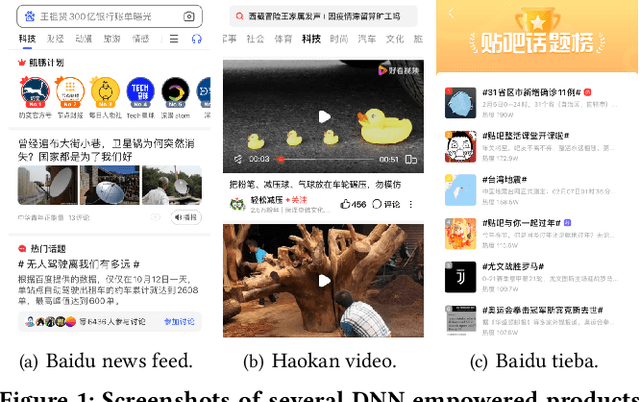

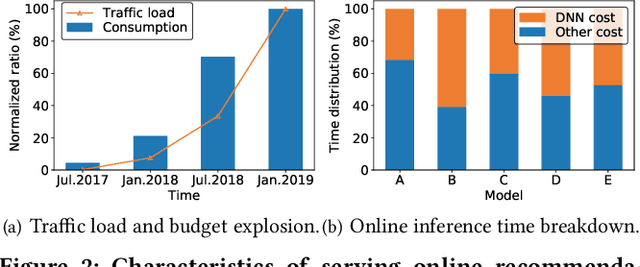
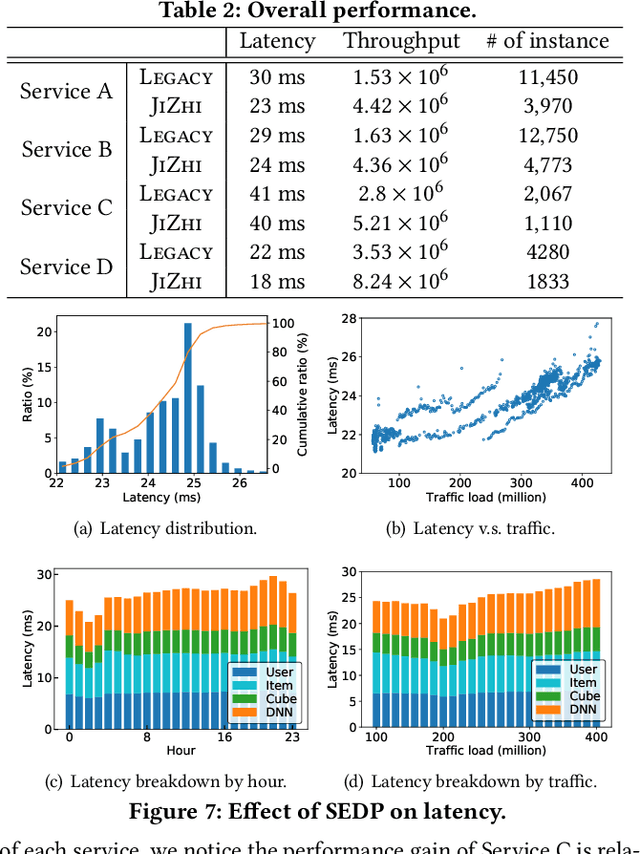
Abstract:In modern internet industries, deep learning based recommender systems have became an indispensable building block for a wide spectrum of applications, such as search engine, news feed, and short video clips. However, it remains challenging to carry the well-trained deep models for online real-time inference serving, with respect to the time-varying web-scale traffics from billions of users, in a cost-effective manner. In this work, we present JIZHI - a Model-as-a-Service system - that per second handles hundreds of millions of online inference requests to huge deep models with more than trillions of sparse parameters, for over twenty real-time recommendation services at Baidu, Inc. In JIZHI, the inference workflow of every recommendation request is transformed to a Staged Event-Driven Pipeline (SEDP), where each node in the pipeline refers to a staged computation or I/O intensive task processor. With traffics of real-time inference requests arrived, each modularized processor can be run in a fully asynchronized way and managed separately. Besides, JIZHI introduces heterogeneous and hierarchical storage to further accelerate the online inference process by reducing unnecessary computations and potential data access latency induced by ultra-sparse model parameters. Moreover, an intelligent resource manager has been deployed to maximize the throughput of JIZHI over the shared infrastructure by searching the optimal resource allocation plan from historical logs and fine-tuning the load shedding policies over intermediate system feedback. Extensive experiments have been done to demonstrate the advantages of JIZHI from the perspectives of end-to-end service latency, system-wide throughput, and resource consumption. JIZHI has helped Baidu saved more than ten million US dollars in hardware and utility costs while handling 200% more traffics without sacrificing inference efficiency.
Safe Multi-Agent Reinforcement Learning through Decentralized Multiple Control Barrier Functions
Mar 23, 2021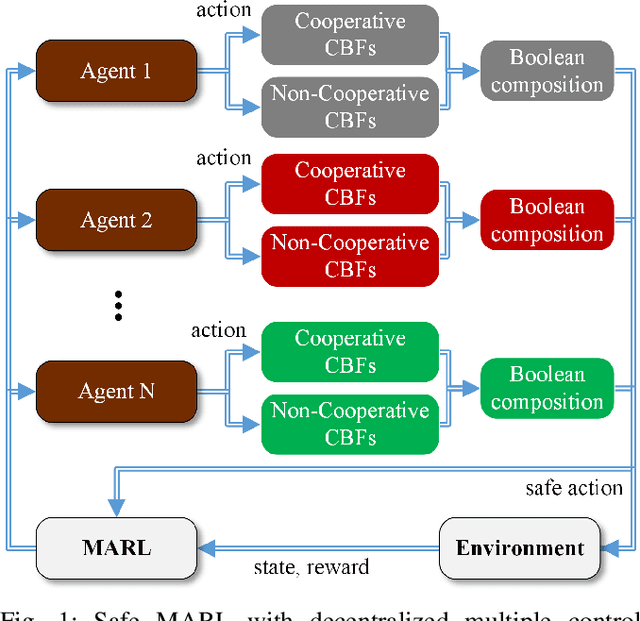
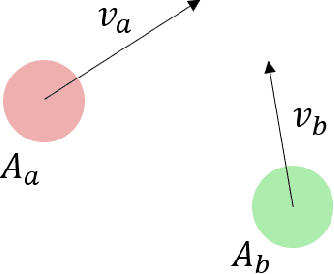
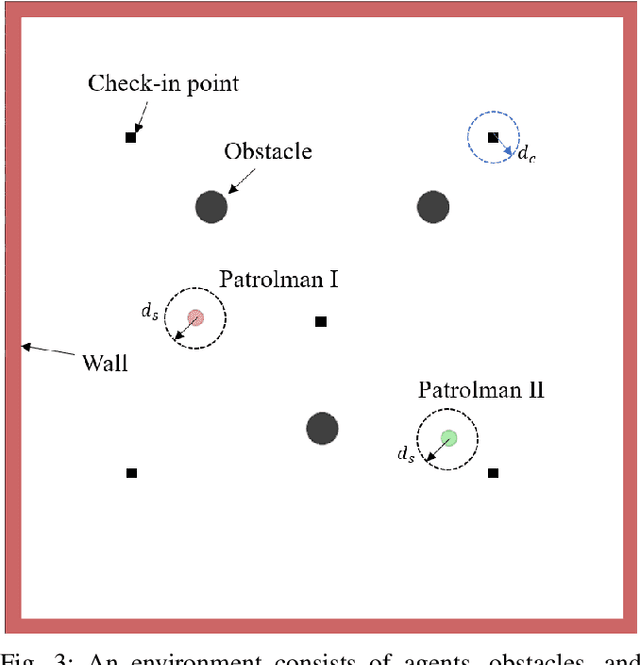
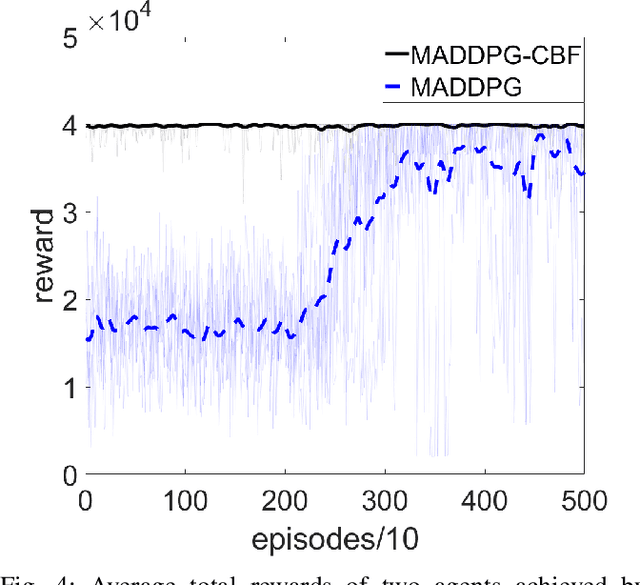
Abstract:Multi-Agent Reinforcement Learning (MARL) algorithms show amazing performance in simulation in recent years, but placing MARL in real-world applications may suffer safety problems. MARL with centralized shields was proposed and verified in safety games recently. However, centralized shielding approaches can be infeasible in several real-world multi-agent applications that involve non-cooperative agents or communication delay. Thus, we propose to combine MARL with decentralized Control Barrier Function (CBF) shields based on available local information. We establish a safe MARL framework with decentralized multiple CBFs and develop Multi-Agent Deep Deterministic Policy Gradient (MADDPG) to Multi-Agent Deep Deterministic Policy Gradient with decentralized multiple Control Barrier Functions (MADDPG-CBF). Based on a collision-avoidance problem that includes not only cooperative agents but obstacles, we demonstrate the construction of multiple CBFs with safety guarantees in theory. Experiments are conducted and experiment results verify that the proposed safe MARL framework can guarantee the safety of agents included in MARL.
Multi-robot Cooperative Object Transportation using Decentralized Deep Reinforcement Learning
Jul 17, 2020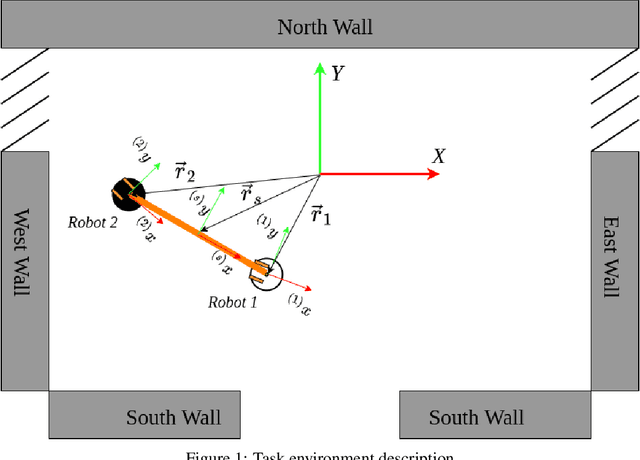

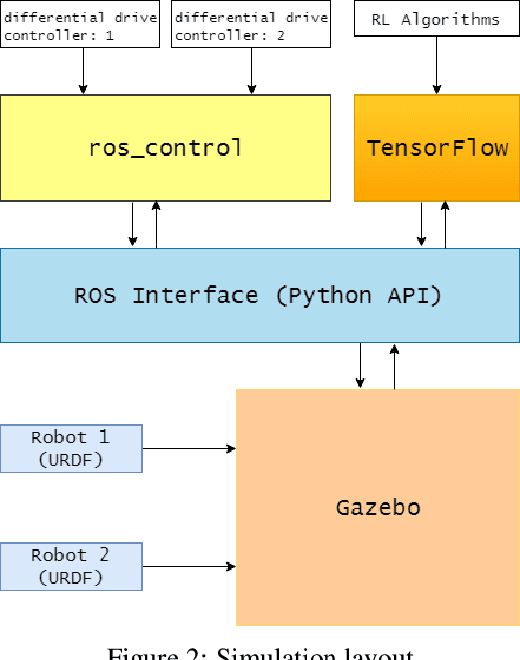

Abstract:Object transportation could be a challenging problem for a single robot due to the oversize and/or overweight issues. A multi-robot system can take the advantage of increased driving power and more flexible configuration to solve such a problem. However, increased number of individuals also changed the dynamics of the system which makes control of a multi-robot system more complicated. Even worse, if the whole system is sitting on a centralized decision making unit, the data flow could be easily overloaded due to the upscaling of the system. In this research, we propose a decentralized control scheme on a multi-robot system with each individual equipped with a deep Q-network (DQN) controller to perform an oversized object transportation task. DQN is a deep reinforcement learning algorithm thus does not require the knowledge of system dynamics, instead, it enables the robots to learn appropriate control strategies through trial-and-error style interactions within the task environment. Since analogous controllers are distributed on the individuals, the computational bottleneck is avoided systematically. We demonstrate such a system in a scenario of carrying an oversized rod through a doorway by a two-robot team. The presented multi-robot system learns abstract features of the task and cooperative behaviors are observed. The decentralized DQN-style controller is showing strong robustness against uncertainties. In addition, We propose a universal metric to assess the cooperation quantitatively.
 Add to Chrome
Add to Chrome Add to Firefox
Add to Firefox Add to Edge
Add to Edge